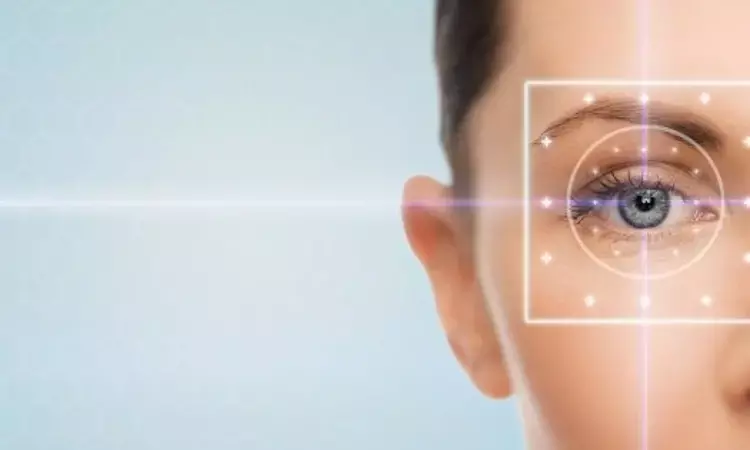- Home
- Medical news & Guidelines
- Anesthesiology
- Cardiology and CTVS
- Critical Care
- Dentistry
- Dermatology
- Diabetes and Endocrinology
- ENT
- Gastroenterology
- Medicine
- Nephrology
- Neurology
- Obstretics-Gynaecology
- Oncology
- Ophthalmology
- Orthopaedics
- Pediatrics-Neonatology
- Psychiatry
- Pulmonology
- Radiology
- Surgery
- Urology
- Laboratory Medicine
- Diet
- Nursing
- Paramedical
- Physiotherapy
- Health news
- Fact Check
- Bone Health Fact Check
- Brain Health Fact Check
- Cancer Related Fact Check
- Child Care Fact Check
- Dental and oral health fact check
- Diabetes and metabolic health fact check
- Diet and Nutrition Fact Check
- Eye and ENT Care Fact Check
- Fitness fact check
- Gut health fact check
- Heart health fact check
- Kidney health fact check
- Medical education fact check
- Men's health fact check
- Respiratory fact check
- Skin and hair care fact check
- Vaccine and Immunization fact check
- Women's health fact check
- AYUSH
- State News
- Andaman and Nicobar Islands
- Andhra Pradesh
- Arunachal Pradesh
- Assam
- Bihar
- Chandigarh
- Chattisgarh
- Dadra and Nagar Haveli
- Daman and Diu
- Delhi
- Goa
- Gujarat
- Haryana
- Himachal Pradesh
- Jammu & Kashmir
- Jharkhand
- Karnataka
- Kerala
- Ladakh
- Lakshadweep
- Madhya Pradesh
- Maharashtra
- Manipur
- Meghalaya
- Mizoram
- Nagaland
- Odisha
- Puducherry
- Punjab
- Rajasthan
- Sikkim
- Tamil Nadu
- Telangana
- Tripura
- Uttar Pradesh
- Uttrakhand
- West Bengal
- Medical Education
- Industry
Augmented Intense Pulse Light therapy may improve Meibomian gland dysfunction and dry eye disease

Sandy Zhang-Nunes and colleagues discovered that intense pulsed light (IPL) has shown great potential in the treatment of refractory Meibomian gland dysfunction (MGD) dry eye disease in a new research. This innovative IPL/ BroadBand Light (BBL™)/ strategy appears to be both safe and effective in the treatment of dry eye and blepharitis. The findings of this study were published in the journal of Photobiomodulation, Photomedicine, and Laser Surgery.
DED, which is frequently coupled with MGD, can cause severe morbidity and accounts for $3.54 billion in health-care costs in the United States each year. With some effectiveness, IPL has been used to treat MGD DED. BBL therapy, which uses high-quality IPL equipment, has a lot of promise for reducing inflammation and redness in rosacea, as well as hyperpigmentation caused by sun exposure.
The purpose of this research was to determine the safety and efficacy of an enhanced BroadBand Light (BBLTM) treatment on the upper and lower eyelids in treating Meibomian gland dysfunction (MGD) and/or dry eye illness (DED). A retrospective medical chart analysis was conducted for MGD DED and/or hyperpigmentation patients who had BBL treatment between January 1, 2015, and February 28, 2020, for this research. Patients who had at least one BBL therapy were eligible for inclusion. The upper and lower eyelids, as well as the cheekbones, nose, and face, were all treated. Each MGD DED patient completed the Ocular Surface Disease Index (OSDI) and performed normal clinical tests before and after therapy.
The results were as follow:
1. Treatment was administered to 47 individuals with no noticeable side effects; all patients with MGD DED reported improvement in their dry eye or blepharitis.
2. BBL has been proven to be a safe and effective therapy. Visual acuity remained same, while OSDI ratings improved.
3. There was one case of minor corneal/conjunctival abrasion, one case of transitory hyperpigmentation, and two cases of temporary eyelash thinning.
4. After BBL therapy, patients with MGD saw considerable improvement in blepharitis and decreased hordeolum frequency.
5. BBL therapy, as shown here, showed considerable improvement for patients who remained symptomatic despite treatment with numerous different modalities for a lengthy period of time, demonstrating the enormous potential for this technique to treat even the most resistant MGD DED.
In conclusion, According to research, treating both the upper and lower eyelids can be not only safer but also more successful if meticulous procedures for eye and eyelash protection and adaptors for the eyelids are developed. This study looked at the safety and efficacy of a high-grade IPL system, BBL, on the upper and lower eyelids as well as the face, and they came up with a unique protocol for dry eye and blepharitis therapy that is both safe and enhances the quality of life for many patients.
Reference:
Zhang-Nunes, S., Guo, S., Lee, D., Chang, J., & Nguyen, A. (2021). Safety and Efficacy of an Augmented Intense Pulse Light Protocol for Dry Eye Syndrome and Blepharitis. In Photobiomodulation, Photomedicine, and Laser Surgery (Vol. 39, Issue 3, pp. 178–184). Mary Ann Liebert Inc. https://doi.org/10.1089/photob.2020.4913
Medical Dialogues consists of a team of passionate medical/scientific writers, led by doctors and healthcare researchers. Our team efforts to bring you updated and timely news about the important happenings of the medical and healthcare sector. Our editorial team can be reached at editorial@medicaldialogues.in.
Dr Kamal Kant Kohli-MBBS, DTCD- a chest specialist with more than 30 years of practice and a flair for writing clinical articles, Dr Kamal Kant Kohli joined Medical Dialogues as a Chief Editor of Medical News. Besides writing articles, as an editor, he proofreads and verifies all the medical content published on Medical Dialogues including those coming from journals, studies,medical conferences,guidelines etc. Email: drkohli@medicaldialogues.in. Contact no. 011-43720751


